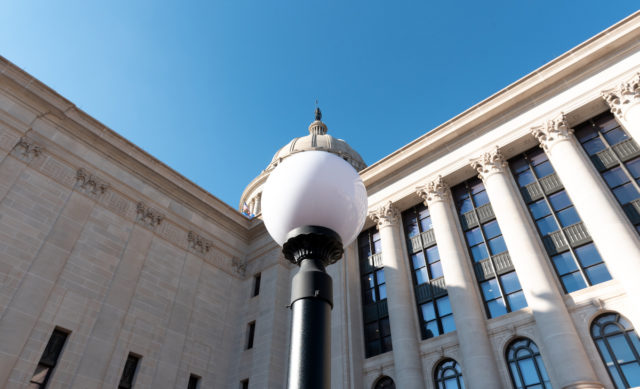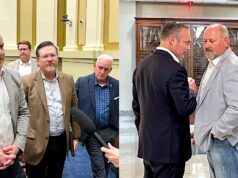

Panasonic has selected a site in Kansas as the home for a new multi-billion-dollar battery factory, according to a story published by Nikkei Asia, a news publication of the Nikkei stock exchange.
Oklahoma leaders have also been attempting to entice Panasonic to build a $4 billion battery plant at the MidAmerica Industrial Park in Pryor. Multiple people with knowledge of those negotiations told NonDoc this afternoon that the company has chosen the Kansas site for its newest manufacturing facility. However, those same people said Panasonic has been considering whether to build a second battery plant, which could ultimately be located in Pryor to take advantage of a nearly $700 million rebate incentive created by the Oklahoma Legislature earlier this year.
“Oklahoma is not totally out of it,” said an individual closely connected to the state’s recruitment efforts on the condition of anonymity. “The electric vehicle market is only growing.”
Senate Appropriations and Budget Chairman Roger Thompson (R-Okemah) said representatives of the Oklahoma Department of Commerce have told him Panasonic is considering the construction of a second battery plant.
“This conversation that I had with Commerce [was] that there may be a second location, and if so we’re still in the running,” Thompson said Wednesday afternoon.
Thompson clarified that his direct conversations with Panasonic officials involved the company building only one plant in either Kansas or Oklahoma. But he said he was subsequently told by Department of Commerce officials that a second plant could be in the cards.
Carly Atchison, the communications director for Gov. Kevin Stitt, also appeared to hint at ongoing recruitment efforts in a statement sent to media.
“Gov. Stitt is confident in his plan to attract companies to Oklahoma,” Atchison said. “This is not the end of the governor’s strategy to make Oklahoma a top 10 state for business, and Oklahomans would be wise to not count us out just yet.”
Background on Oklahoma rebate incentive

For now, however, the Japanese company’s anticipated $4 billion plant is expected to be constructed at a new industrial park in De Soto, Kansas. The plant would bring about 4,000 new jobs to the Kansas City area.
Thompson said he is “very disappointed that we didn’t get” the plant reportedly planned for Kansas.
“I wish that we would have worked harder to get it,” Thompson said. “But we didn’t.”
Thompson and other Oklahoma political leaders made a strong push this spring to convince the Japanese company to build a facility at the MidAmerica Industrial Park in Pryor.
In April, Oklahoma legislators passed an incentive package tailored specifically for a project the size of the proposed battery plant. Legislators, lobbyists and executive branch staff referred to the effort as “Project Ocean,” despite broad knowledge throughout the Capitol of the company’s identity.
Oklahoma’s incentive package offered a straight 3.4 percent rebate for projects worth at least $3.6 billion in capital expenditures. Lawmakers created the new incentive program in HB 4455 and dubbed it the Large-scale Economic Activity Development Act, or LEAD Act. The program featured investment and hiring benchmarks aimed at safeguarding the $698 million in cash that legislators deposited into the LEAD Fund.
If no other large-scale economic development project qualifies for the LEAD rebate program — such as a second Panasonic battery plant — lawmakers will be able to repurpose that $698 million during special session or the 2023 regular session.
In April, House Speaker Pro Tempore Kyle Hilbert (R-Depew) presented HB 4455 in the House committee and spoke of “safeguards” that make the LEAD Act different from prior incentive programs “where we have no caps on a fund (and) it’s just kind of growing and growing and growing out of control.”
Hilbert said lawmakers can still “look at this legislative framework” created this year “to do more in the future.”
Background on the Kansas incentive package
Panasonic’s new battery plant will be the initial tenant in a new industrial park site in De Soto, Kansas, a small city in the Kansas City metro area. Formerly the Sunflower Army Ammunition Plant, the site has been remediated by the U.S. Army Corps of Engineers after the city of De Soto annexed about two-thirds of the plant for creation of the industrial park.
In February, the Kansas Legislature passed an incentive package worth up to $1.3 billion in tax credits, sales tax exemptions, relocation reimbursements, payroll rebates and job training programs to entice Panasonic into the state.
Kansas Gov. Laura Kelly is expected to announce the economic development news at 5 p.m. Wednesday.
Panasonic has existing agreements with Tesla, which has a new factory in Austin, and Canoo, another electric vehicle manufacturer that has announced plans for manufacturing and research operations in northeast Oklahoma. But investment concerns and cash flow questions could delay Canoo’s development plans in Oklahoma, the Tulsa World reported July 1. This week, however, the company’s stock price doubled after Walmart announced plans to buy 4,500 of Canoo’s electric vehicles.
The LEAD Act created by the Oklahoma Legislature earlier this year included the potential for Canoo to qualify for some enhanced state business incentives related to an expanded Quality Jobs Act program, but only if the Panasonic battery plant came to fruition in Oklahoma. (That component is outlined on Page 7 of the bill.)




















